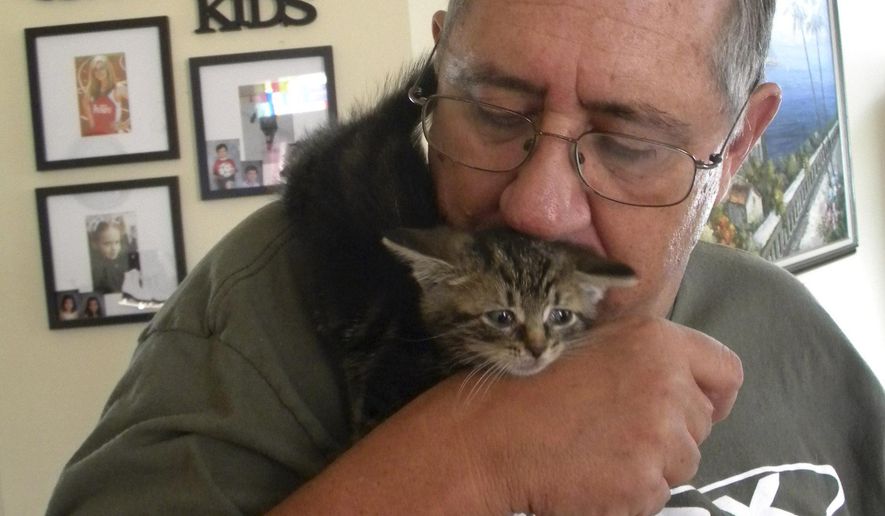This picture was taken October 14, 2014. This post is just a reminder, no matter where we are, that our friends need us. Tomorrow we will resume our regular programming.

Following is an article about stray cats in West Virginia, but it of course is true of many places.
Stray cat crisis hits W.Va.'s Eastern Panhandle - Washington Times
www.washingtontimes.com
ADVANCE FOR MONDAY OCT. 20 AND THEREAFTER- This Tuesday Oct. 14, 2014 photo shows John Kracke as he holds a 5-week-old kitten named Sparky in Charles Town, ..
By CHELSEA DeMELLO - Associated Press - Sunday, October 19, 2014
CHARLES TOWN, W.Va. (AP) - Although animal shelters and foster owners around the Eastern Panhandle have struggled for years to find a way to decrease the stray cat population, the problem has only gotten worse.
The vicious cycle of constant reproducing, along with pet owners unable to care for their pets, has added to the issue, leaving countless animals to roam the streets in search of food and shelter.
Patsy McCracken, an advocate who rescues cats throughout Jefferson County at her own expense, expressed concerns of the ongoing issue, after telling the story of Sparky, a three-week-old kitten rescued from the middle of a local highway.
“She had been sitting in the middle of U.S. 340 with cars just going around her. She was so young, her eyes were just matted shut. She couldn’t even see to move,” McCracken said.
But Sparky was one of the lucky kittens.
An injured long-haired Persian found behind Ruby Tuesday in Charles Town was not so lucky after being attacked by a fox.
“By the time I finally got a hold of him, you could just smell the infection. I took him to the vet and his skin was so deteriorated, the doctor couldn’t even put a stitch in him. I made the decision to send him to kitty heaven,” she said.
With cats constantly being turned away and left along the streets, it is no surprise that animal shelters around the area have been left to pick up the slack.
Nearly every animal shelter around the area remains at capacity with unwanted animals. While dogs make up a certain percentage of those animals, the number of abandoned cats in each shelter is more than double.
“Every year we have this problem. … There are feral cats everywhere,” said Sheri Persad, president of the Berkeley County Humane Society.
The issue has become so critical, sometimes the shelter is forced to euthanize animals to make room, Persad said.
With BCHS being the only “kill” animal shelter in the Eastern Panhandle, its doors are constantly flooded with animals from outside the county.
“Just yesterday there were 14 cats sitting on the front door when we got there,” Persad said.
Persad said the No. 1 solution to the problem would be to ensure people are educated about the responsibilities that come with being a pet owner, which means having the animals spayed or neutered.
“If someone can’t afford to spay and neuter their pet, then they shouldn’t have pets, because if they can’t afford $50 to get the animal fixed, what is going to happen when the pet gets sick?” Persad said.
To reduce the burden of having the animals fixed, area shelters will provide relief programs that help with the financial costs of caring for the pets.
In addition, the Animal Welfare Society of Jefferson County also has foster support for citizens interested in providing temporary relief.
“We supply all of the food and shots. All they need to do is provide a home,” said Dottie Kracke, vice president of the Animal Welfare Society of Jefferson County.
Despite these programs and efforts by surrounding communities to control the cat population, without state and local legislation, relief can only go so far.
Currently, there are no ordinances within the Eastern Panhandle to limit the increasing feral cat population.
Animal control also has its hands tied, according to Denise Lambiotte, a supervisor for Jefferson County Animal Control.
Lambiotte said animal control receives calls daily from citizens inquiring about what to do with the cats.
But without local laws, the only support animal control can provide is if the animal becomes dangerous to humans, Lambiotte said. “There could certainly be state laws put in place that trickle down to the city level. …There just hasn’t been a push by state lawmakers to address it,” she said.
Until then, pet advocates, good Samaritans and animal shelters around the area are left to carry the burden.
“These cats don’t ask to be treated like this. When they become injured or poisoned, they have to lay there and die. And that’s not fair,” McCracken said. “So if I can spare just one life, then it’s worth it.”
No comments:
Post a Comment